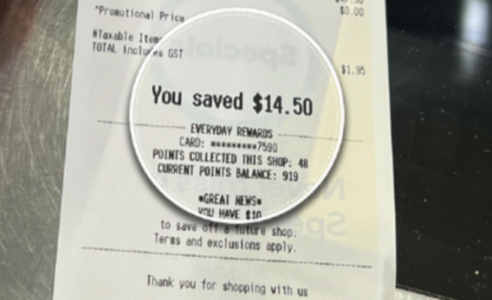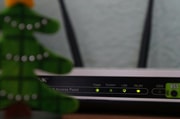Supermarkets' secret weapon for seducing shoppers decoded
- Replies 12
We've all been there: you're checking out at the supermarket, and the cashier hands you your receipt. As you stuff it into your bag, you catch a glimpse of bold text saying, 'You saved $14.50.'
A wave of satisfaction comes over you. You got a great deal! You can't wait to come back to this store for more savings.
Sound familiar? Well, we hate to break it to you, but you've been duped by one of the sneakiest tricks in the supermarket playbook.
Those 'savings' on your receipt are actually also a psychological tactic designed to manipulate you into becoming a loyal, repeat customer. Here's how it works…

See, supermarkets know that when we feel like we've scored a good deal, our brain releases dopamine—that feel-good chemical that gives us a rush.
On your receipt, the store shows you the dollars you 'saved' compared to their made-up normal prices. This makes you feel smart for spending less. It's giving your brain a little dopamine hit.
Retailers and supermarkets know dopamine is addictive! Consumer Psychologist Peter Resanceff says this receipt trick creates 'a significant positive response at the most painful point of the shopper's journey’.
After handing over your hard-earned cash, you get a mood boost from the receipt. Pretty soon, you start associating that store with feeling good.
You're more likely to come back again and again, chasing the savings high.
'The shopper effectively leaves the retailer on a little high, perhaps numbed to the pain of the much larger dollar value on the docket,' added Mr Resanceff.
Think you're safe with a digital receipt? Think again. Chemist Warehouse’s digital app takes the tactic further by showing your savings front and centre with graphics and animations. The dopamine hits keep coming!
But before you rush back to that store expecting more savings, here's the truth: those receipt savings claims are meaningless unless you confirm them yourself.
See, every store is going to say you saved money there. But only you can check if you've saved some bucks or if the store prices are the lowest.
Next time you shop, do some legwork first:

So don't let sneaky marketing tactics fool you, members! Doing a bit of homework pays off.
Check for yourself if those savings are real, and feel genuinely good knowing you found the best deals. Your wallet will thank you!
Do you have other supermarket tips and advice? Leave them in the comments below!
A wave of satisfaction comes over you. You got a great deal! You can't wait to come back to this store for more savings.
Sound familiar? Well, we hate to break it to you, but you've been duped by one of the sneakiest tricks in the supermarket playbook.
Those 'savings' on your receipt are actually also a psychological tactic designed to manipulate you into becoming a loyal, repeat customer. Here's how it works…

Supermarket receipts have a particularly effective feature to entice customers to return to stores. Credit: 9Honey.
See, supermarkets know that when we feel like we've scored a good deal, our brain releases dopamine—that feel-good chemical that gives us a rush.
On your receipt, the store shows you the dollars you 'saved' compared to their made-up normal prices. This makes you feel smart for spending less. It's giving your brain a little dopamine hit.
Retailers and supermarkets know dopamine is addictive! Consumer Psychologist Peter Resanceff says this receipt trick creates 'a significant positive response at the most painful point of the shopper's journey’.
After handing over your hard-earned cash, you get a mood boost from the receipt. Pretty soon, you start associating that store with feeling good.
You're more likely to come back again and again, chasing the savings high.
'The shopper effectively leaves the retailer on a little high, perhaps numbed to the pain of the much larger dollar value on the docket,' added Mr Resanceff.
Think you're safe with a digital receipt? Think again. Chemist Warehouse’s digital app takes the tactic further by showing your savings front and centre with graphics and animations. The dopamine hits keep coming!
But before you rush back to that store expecting more savings, here's the truth: those receipt savings claims are meaningless unless you confirm them yourself.
See, every store is going to say you saved money there. But only you can check if you've saved some bucks or if the store prices are the lowest.
Next time you shop, do some legwork first:
- Compare prices for the items you buy regularly across 3-4 supermarkets
- Look up any weekly specials and discounts at each store
- See which has the lowest regular prices on essentials like milk, bread, eggs
- Use an app like ShopSavvy to scan and compare barcode prices
- Pay attention to unit pricing (cost per 100g, etc.)
Key Takeaways
- Supermarket receipts, aside from providing a purchase summary, are also marketing tools designed to entice customers to return to the store.
- Consumer Psychologist and Brand Strategist Peter Resanceff says the goal of receipts is to trigger a dopamine hit in the customer when they see how much they've 'saved'.
- This 'saving' strategy is becoming more obvious as receipts transition into digital versions, with each item often listing a full price and the 'saving' made.
- Shoppers are encouraged to compare prices and research weekly specials to ensure they are truly getting the best value for their money.
So don't let sneaky marketing tactics fool you, members! Doing a bit of homework pays off.
Check for yourself if those savings are real, and feel genuinely good knowing you found the best deals. Your wallet will thank you!
Do you have other supermarket tips and advice? Leave them in the comments below!







